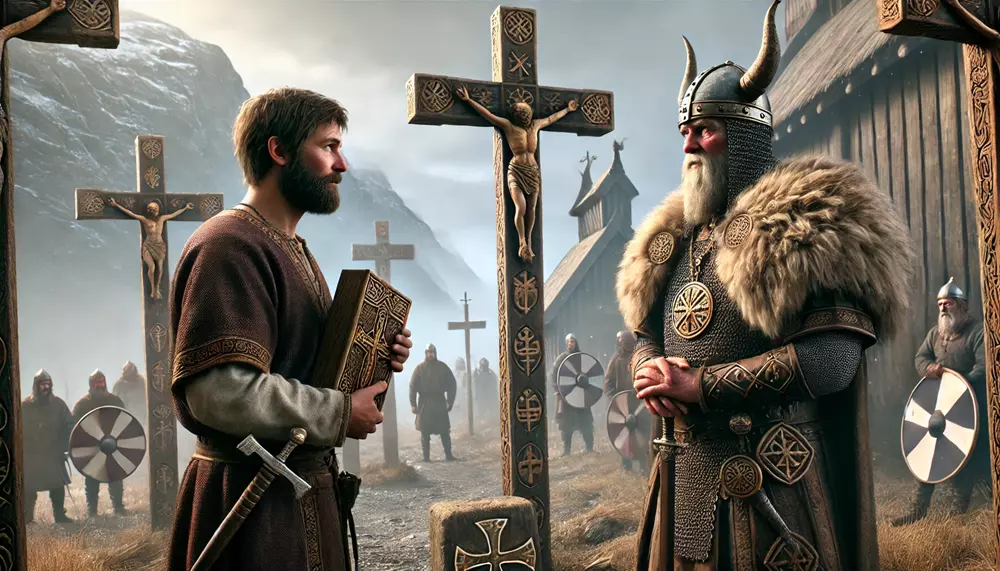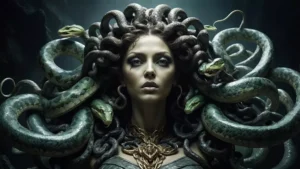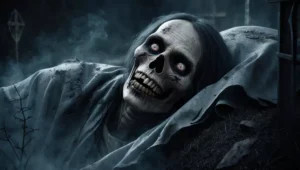As Christianity spread throughout Europe and the wider world, it encountered and interacted with a wide array of local pagan religions, each with its own gods, rituals, and symbols. Instead of attempting to eliminate these belief systems, early Christian leaders often adapted elements of local mythology to ease the transition, a process known as religious syncretism.
This blending is evident in the way Christianity adopted pagan gods, mythical creatures, and holy days, gradually transforming them to fit Christian narratives. By repurposing pre-existing symbols and festivals, Christianity became more palatable and familiar to converts, allowing it to integrate more deeply into diverse cultures. As a result, figures like the Celtic Brigid, Norse Thor, and Slavic Perun were absorbed into Christian lore, often reimagined as saints or symbols of Christian virtues
Paganism Meets Christianity: An Age of Syncretism
In its earliest days, Christianity often existed alongside and in dialogue with pagan traditions. Rather than opposing these beliefs, Christian leaders strategically adapted them to gain acceptance within various cultures. This blending approach is illustrated by the transformation of pagan holidays into Christian celebrations.
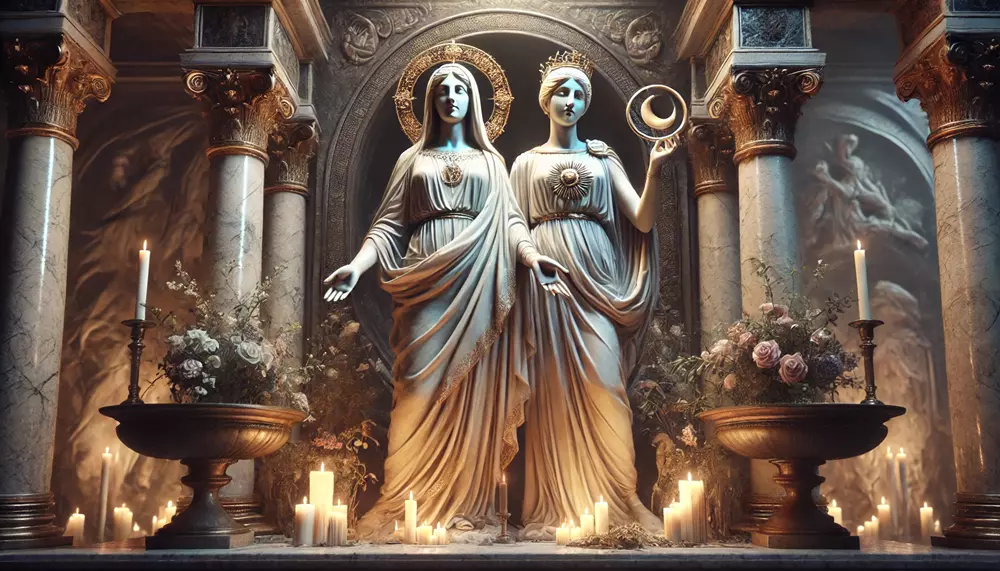
For instance, the Christian feast of the Assumption of Mary was intentionally aligned with the Roman festival of Diana, goddess of the hunt. By aligning Mary’s celebration with Diana’s, Christianity facilitated the acceptance of its doctrines among converts who were familiar with Diana’s attributes
“For we must respect their customs, yet illuminate them in the way of the faith,” (Early Christian Missionary Texts)
This syncretic method extended beyond festivals to include the gods themselves. In Roman and Greek territories, the interpretatio Romana (Roman interpretation) identified foreign gods as equivalent to Roman deities, making it easier to introduce Christian saints who shared attributes with these deities.
In this way, the Roman god Janus, associated with doorways and transitions, found a parallel in the role of Saint Peter as the “keeper of heaven’s gates.” This adaptation strategy created a bridge between paganism and Christianity, allowing converts to retain familiar figures and symbols within a new religious context

From Pagan Gods to Christian Saints
As Christianity continued to spread, many pagan deities and mythological figures found new life as Christian saints. This transformation was often deliberate, as missionaries recognized that familiar gods and heroes could foster a smoother transition to Christianity if they were reimagined in a Christian framework.
For example, the Irish goddess Brigid, associated with fire, healing, and the hearth, was repurposed as Saint Brigid of Kildare, one of Ireland’s most beloved saints. By integrating Brigid’s attributes into a Christian narrative, the church preserved the symbolism while encouraging reverence within a Christian context

In Norse mythology, the thunder god Thor symbolized protection and strength, attributes that were later associated with the archangel Michael, who also embodied warrior qualities in Christian mythology. Saint Michael’s imagery often included depictions of dragon-slaying, mirroring Thor’s battles against serpents and giants.
Similarly, in the Slavic regions, the thunder god Perun’s qualities were ascribed to Saint Elijah, known for bringing rain and storms. Through these adaptations, Christianity repurposed powerful figures from existing mythologies, recasting them as Christian heroes or protectors to build cultural continuity
Transformed Beasts, Gods, and Heroes
Not only were gods and heroes repurposed within Christianity, but many mythical creatures were also adapted into Christian mythology. Beasts like dragons, phoenixes, and griffins—once revered or feared in pagan beliefs—took on new meanings in Christian symbolism.
In the pagan East, dragons were often considered symbols of wisdom or guardianship. However, Christianity redefined dragons as embodiments of evil, symbolizing the chaos and sin vanquished by saints. One of the most famous examples is the legend of Saint George and the dragon, where George, a Christian saint, defeats a dragon, representing the triumph of Christianity over pagan forces
“The dragon did rage, yet by the saint’s spear was it vanquished, as evil lies under the heel of faith.” (Christian Legend of Saint George)
Another creature, the phoenix, originated in ancient Egyptian and Greek mythologies as a symbol of rebirth. As Christianity integrated this symbol, the phoenix became associated with the concept of resurrection, serving as a metaphor for Christ’s death and return to life.

Similarly, the griffin—a creature with the body of a lion and the head of an eagle—was reimagined as a symbol of Christ’s dual nature, blending human and divine attributes. These transformations illustrate Christianity’s tendency to repurpose familiar pagan symbols, allowing the new religion to incorporate aspects of the old belief systems while aligning them with Christian doctrines
Preserving Paganism Through Saints and Symbols
The transition from paganism to Christianity often involved the preservation of certain sacred elements, which were recontextualized within Christian narratives. Trees, rivers, and animals that were once central to pagan spirituality became symbols of Christian sanctity.
In Celtic regions, sacred trees like the oak retained spiritual significance, sometimes associated with saints or Christian martyrs. For instance, Irish tales often depict hawthorn trees as “fairy trees,” retaining their sacred status within Christianized folklore.
Another figure transformed through syncretism is Saint Nicholas, who traces some origins to winter deities like Odin. Before becoming Santa Claus, Saint Nicholas was linked to attributes of the Norse god Odin, a bearded figure associated with winter and supernatural wisdom.
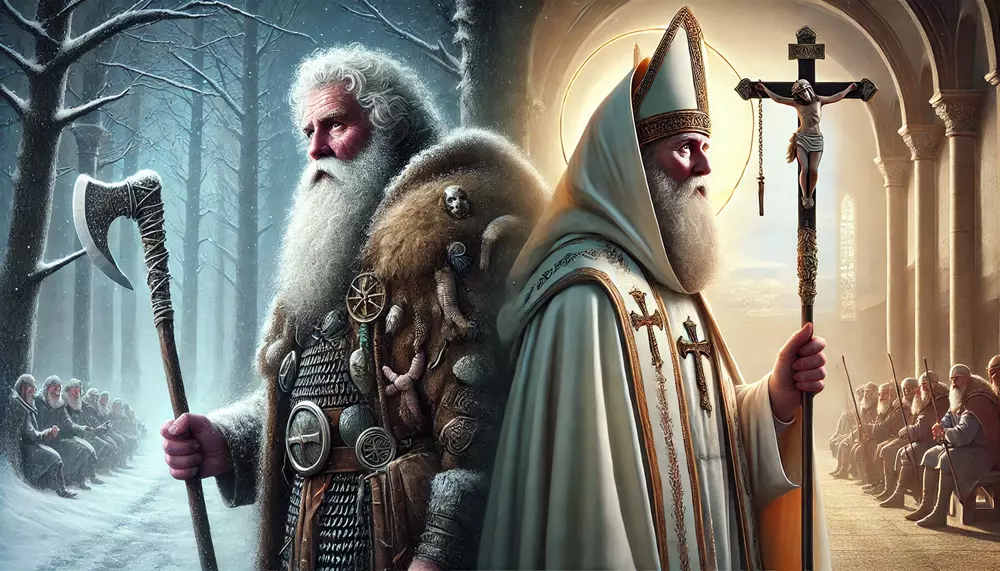
In Germanic regions, stories of “Wild Hunts” led by spirit-gods like Odin evolved into legends surrounding Saint Nicholas and his winter journey. These narratives, steeped in pagan tradition, were modified and integrated into Christian culture, allowing the holiday of Christmas to blend seamlessly with pre-existing winter festivities
“As the tree roots seek water, so does the heart seek truth, finding the divine in the oak, the river, and the sky.” (Early Celtic Christianity)
This approach also extended to animal symbols. The Celtic stag, once a representation of Cernunnos, the god of the forest, was adopted as a Christian symbol representing Christ. The lion, a symbol associated with the Roman god Mithras, became a representation of strength and protection in Christian iconography. By retaining these symbols, Christianity enabled cultural continuity, preserving the spiritual significance of pagan beliefs while encouraging the worship of a single Christian god.
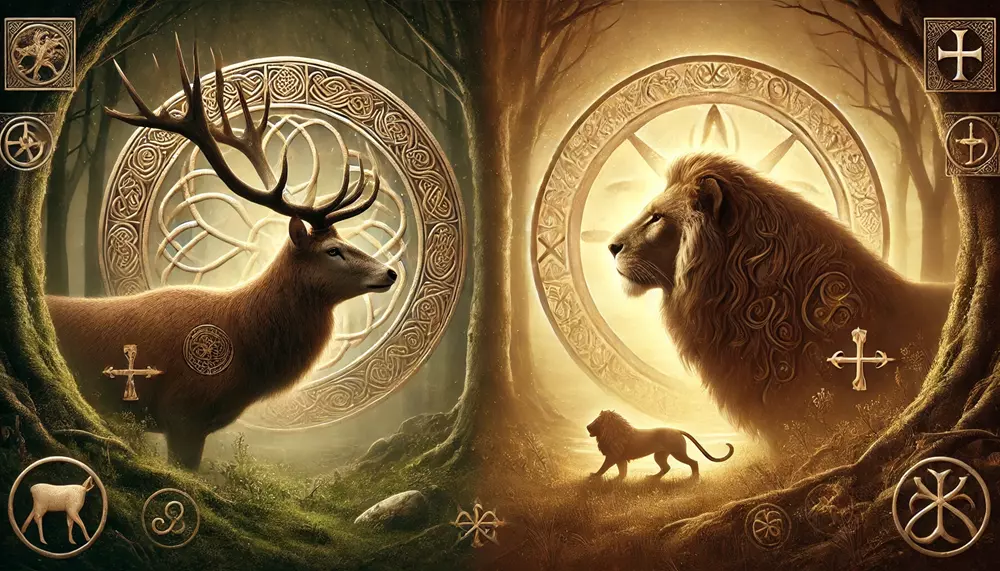
Adapted Legends: Folklore Becomes Canon
Christianity’s integration of pagan mythology extended beyond gods and beasts, incorporating well-loved local legends into its lore. Folktales and cultural myths that once centered on nature spirits, heroes, and local deities were reinterpreted to fit Christian virtues and morals, thus becoming part of the Christian canon.
For instance, the story of the Wild Hunt—a spectral phenomenon where a ghostly procession of hunters rode through the skies—was reshaped in Christian contexts as a harbinger of divine justice. In some regions, the hunt leader was reimagined as Saint Nicholas or other saints, symbolizing the divine judgment cast upon the wicked or a warning to live righteously.
Similarly, the myth of the Green Man, a figure representing nature’s cyclical rebirth, was absorbed into Christian iconography. Green Men began to appear in the ornamentation of churches, symbolizing resurrection and eternal life. The Green Man’s presence on church walls and carvings illustrates how Christianity adopted regional symbols to create connections with familiar beliefs.

Other figures, like the Irish banshee or Scottish wraiths, became cautionary tales in Christian storytelling, often recast as spirits warning of impending death, aligning with Christian teachings on mortality and the afterlife.
In many cases, Christianity allowed local legends to survive by reframing them with Christian morals, creating narratives that resonated with local cultures. These stories, though altered, preserved elements of their original pagan meaning while encouraging Christian virtues, thus fostering a blend of faith and folklore.
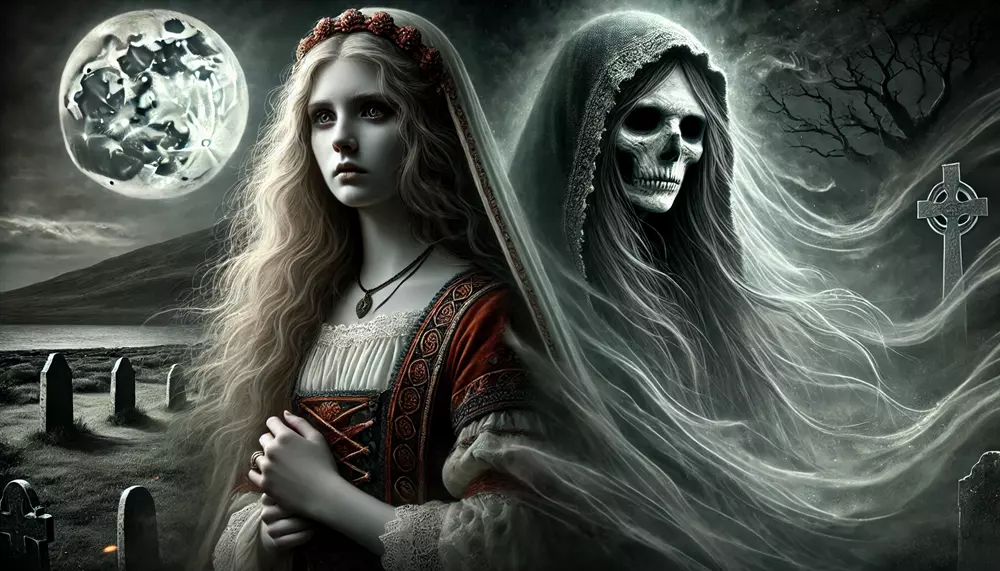
Sacred Beasts and Symbolic Figures in Christianity Mythology
The transformation of mythical beasts within Christian mythology served as an important bridge between Christianity and pagan beliefs. Symbols like lions, eagles, serpents, and even wolves—creatures once imbued with deep mythological significance—were reinterpreted as representations of Christian ideas.
The lion, for example, an ancient symbol of royalty and power, became associated with Saint Mark and depicted as a guardian of faith. Similarly, the eagle, a symbol of divine strength in various mythologies, was adapted as a Christian symbol of ascension, representing John the Evangelist and the soul’s ascent to heaven.
Another example is the phoenix, a bird that embodies the cycle of life, death, and rebirth in ancient Egyptian and Greek mythology.

In Christianity, the phoenix symbolized the resurrection of Christ, depicting how faith could transform death into eternal life. This adaptation allowed pagans to see their sacred symbols reinterpreted through a Christian lens, creating a natural and familiar resonance with the Christian doctrine.
Dragons, common in European mythology as either wise or dangerous beings, were often depicted as evil in Christianity, representing Satan or the embodiment of sin.
Stories of saints like Saint George and Saint Martha slaying dragons became allegories for Christian triumph over pagan beliefs. These tales of dragon-slaying exemplified the Christian narrative of good conquering evil, aligning Christian teachings with existing mythological themes. By repurposing these animals and mythical creatures, Christianity created symbols that resonated with local populations, fostering familiarity with the faith.
Christianity’s Evolving Mythology in Modern Culture
As Christianity evolved, it continued to integrate symbols and traditions from pagan beliefs, even into the modern era. Many of today’s Christian holidays, like Christmas and Easter, still carry traces of their pagan roots. Christmas, celebrated on December 25th, coincides with the Roman festival of Saturnalia and the winter solstice celebrations, honoring the rebirth of the sun.
Symbols like the Yule log, Christmas tree, and mistletoe are remnants of these ancient traditions, repurposed into the celebration of Christ’s birth. Similarly, Easter—celebrating the resurrection of Christ—is associated with symbols like the egg and rabbit, both of which originated in spring fertility festivals.
Modern Christianity also preserves folklore through its festivals, iconography, and even rituals, bridging the past with the present. For instance, the veneration of saints in Catholicism reflects the preservation of ancient godlike figures reimagined within Christian contexts.
Saints like Saint Christopher, a protector of travelers, reflect the function of deities once invoked for safe passage. This ongoing syncretism demonstrates how Christianity continues to draw upon ancient myths, creating a legacy where faith and folklore coexist.
Today, Christian symbols and rituals resonate with the echo of ancient beliefs, proving that religious syncretism remains a vital part of cultural continuity. The continued integration of these symbols serves as a reminder that mythology and faith are interconnected, allowing ancient practices to survive within a modern religious framework.
Conclusion: Mythology’s Timeless Influence on Faith
The enduring presence of pagan symbols, gods, and legends within Christianity reflects a timeless connection between myth and faith. By embracing elements of local beliefs and reshaping them within a Christian framework, early Christian leaders built a faith that was both new and familiar to converts. Saints replaced gods, festivals honored Christian ideals while respecting cultural customs, and mythical beasts became symbols of Christian virtues.
This integration created a unique mythology within Christianity that honored the old beliefs while introducing a new faith.
Today, Christianity continues to carry traces of its mythological roots, from symbols like the cross and the fish, to the presence of ancient festivals reborn as Christian holidays.
The legacy of religious syncretism between Christianity and paganism highlights the adaptability of faith in its ability to absorb and repurpose beliefs to bridge communities and cultures. This fusion of myth and religion illustrates the timeless power of storytelling, providing both continuity with the past and a pathway for spiritual growth. Through the lens of Christianity mythology, we see how faith can evolve and thrive by embracing the wisdom, values, and symbols of those who came before.
Sources:
The Influence of the Mystery Religions on Christianity – King Institute at Stanford University
Christianity and Graeco-Roman Paganism – St. Andrews Encyclopedia of Theology
Syncretism and Religious Change – Cambridge Core
From Paganism to Christianity in Medieval Europe” – Oxford Academic

